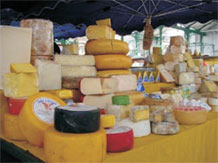How is brucellosis transmitted to humans, and who is at risk?
Humans become infected in three ways: if they eat or drink something contaminated with Brucella, if they inhale the organism or if bacteria enters the body through the skin wounds. The most common way is eating or drinking the contaminated dairy products.

When a sheep, cow or goat is infected, their milk is also infected. If the milk is not pasteurized, these bacteria can be transmitted to persons drinking the milk or eating the cheese made of that kind of milk. Inhaling the Brucella organisms is not a very common way of infection, but it can represent a significant risk for persons in certain occupations, such as those working in laboratories where the organism is cultured.
Abattoir employees often become infected by inhaling the bacteria. The contamination of skin wounds can be a problem for persons working in slaughterhouses, or meat packing plants or veterinarians. Hunters can become infected through skin wounds or by ingesting the bacteria. The bacteria causing this illness is found in unpasteurized milk of the infected cows, in the all secretions of the cattle or goats that abort their fetus. This disease is not transmitted from person to person. However, infected mothers may transmit the infection to their babies through breast milk.